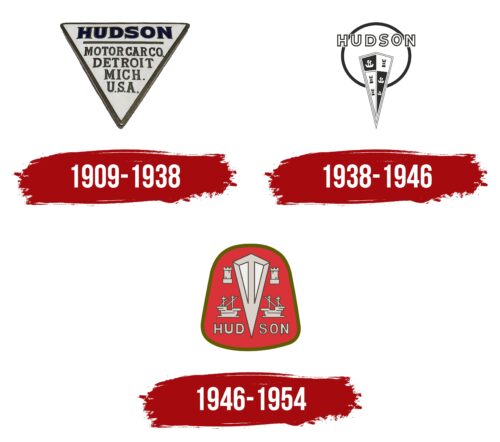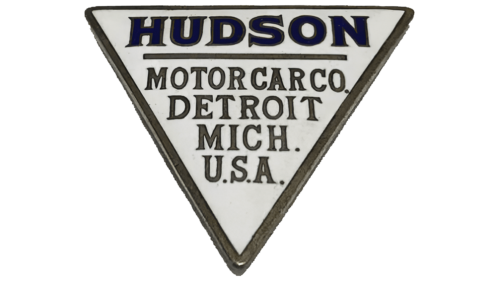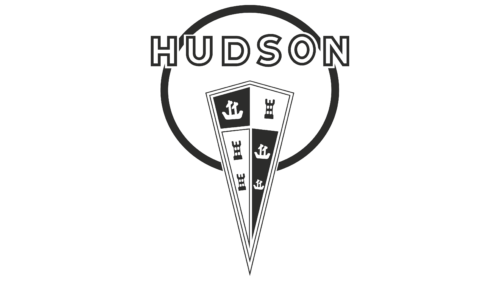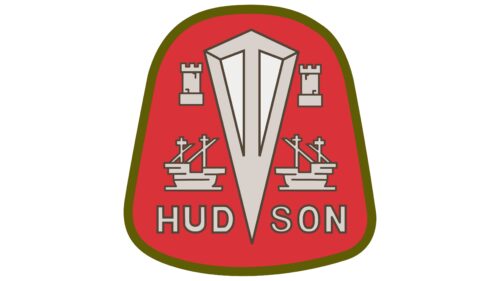The Hudson logo is filled with historical events and iconic moments. The emblem is closely connected to the founder’s surname and ancestors. The symbols represent reliability and exciting journeys, made possible for many years by the brand’s advanced models.
Hudson: Brand overview
Emerging from Detroit’s automotive landscape in 1909, Hudson Motor Car Company was the brainchild of visionaries, including Joseph Hudson and Roy Chapin. Their debut offering, the Hudson Model 20, powered by a 20-horsepower engine, laid the foundation for Hudson’s commitment to excellence and robust performance.
Hudson experienced a surge in popularity during the 1920s, unveiling models under the Essex range and positioning itself as a middle-tier brand. Its ascent was such that, by the end of the 1920s, it had clinched the title of the third-largest car manufacturer in the U.S. Hudson’s innovative streak manifested in breakthroughs such as dual braking systems and a revolutionary balanced straight-eight engine that ensured a lower center of gravity, amplifying its dominance in the 1930s and 40s.
However, the post-WWII era presented challenges for Hudson, as they grappled with archaic designs that didn’t resonate with evolving consumer preferences. Seeking solace in collaboration, Hudson amalgamated with Nash-Kelvinator in 1954, giving rise to the American Motors Corporation (AMC). Although AMC momentarily sustained both Hudson and Nash models post-merger, by 1957, the Hudson marque was relegated to history. Over its nearly half-century lifespan, Hudson had crafted over 3 million vehicles, reaching its zenith in the postwar years as the world’s 11th most prodigious car manufacturer.
Today, even though Hudson’s manufacturing endeavors have ceased, its legacy is revered by fans and car enthusiasts through various collector circles and events dedicated to this iconic brand.
Meaning and History
What is Hudson?
From 1909 to 1954, the Hudson Motor Car Company significantly impacted the car industry with their superior automobiles made in the heart of Detroit, Michigan. The company, co-founded by visionaries like Joseph L. Hudson, Roy D. Chapin, and A.E. Barit, rapidly secured a prominent position in the auto sector. In 1954, an alliance was formed with Nash-Kelvinator, birthing the American Motors Corporation (AMC). Despite this, the Hudson continued its car production until the release of the 1957 models. While the firm no longer exists, Hudson remains a beacon of automotive ingenuity and superior quality.
1909 – 1938
Hudson’s first emblem, used from 1909 to 1938, was an inverted triangle. This shape resembled the look of car radiators at the time and symbolized three key brand values: quality, beauty, and reliability. Inside the logo were the full details of the manufacturer, including the company name, line of work, city, state, and country.
The brand name came from Joseph L. Hudson, an influential businessman from Detroit who provided financial support for the company’s founding and allowed his name to be used. Joseph L. Hudson was known for his entrepreneurial activities and contributions to Detroit’s development. His investments and support were crucial in establishing Hudson Motor Car Company.
The company’s manufacturing facilities were located in Michigan, where Joseph L. Hudson lived after emigrating and ran several successful businesses. With its growing automotive industry, Michigan was ideal for Hudson’s car production. The company’s emblem symbolized the technical and aesthetic standards of the brand and served as an informational sign that helped distinguish various ventures and locations associated with the Hudson name.
1938 – 1946
By 1938, Hudson car designs featured the famous elongated fin on the hood, a recognizable brand trait. This element was symbolically represented in the emblem as a triangle. The downward-pointing triangle in the logo indicates the brand’s innovation—leaf springs. These springs significantly improved ride comfort and smoothness, emphasized by the circle symbol in the emblem.
The images on the triangle held heraldic significance, reflecting the company’s rich history and traditions. The heraldic symbols in the design highlighted respect for the past and the company’s scale and importance in the automotive market. The Hudson emblem symbolized confidence in the future, showcasing the company’s readiness for further innovations and growth.
1946 – 1954
The last brand logo before the merger with Nash-Kelvinator was heraldic. It became a unique monument, immortalizing the company’s founder’s name.
The logo’s shape resembled a shield. Sharp triangular corners were softened to convey the streamlined design of the cars. The shield emphasized the reliability of the vehicles. The brand offered a lower-body design, which provided better handling and passenger safety.
The images on the shield did not seem directly related to cars. They were significant in the context of the brand’s history and understanding. The figure in the center was a prototype of the Hudson brand’s distinctive hoods, remembered by customers. The drawings on the right and left mirrored each other, emphasizing the harmony and beauty of the cars.
The entrepreneur after whom the company was named came from Newcastle upon Tyne, England. The towers on the emblem highlighted the automotive giant’s historical roots. The drawing symbolized the first funds that founded the brand, representing the cars’ strength, stability, and endurance.
The ships at the bottom drew a parallel between the company’s name, a famous river, and a bay in America. These waterways were named after the English explorer, possibly a namesake or distant ancestor of Joseph L. Hudson. Just as the pioneer Henry Hudson discovered new shores in the 1600s, the company pioneered the automotive world, making many discoveries.
The division of the surname into two parts symbolizes the founder’s life in England and then in America. This refers to the surname’s origin, formed from the name Hudd and the suffix son. The car brand is like the son of Joseph L. Hudson. He gave it his name, and the company continued his legacy since he died childless.







